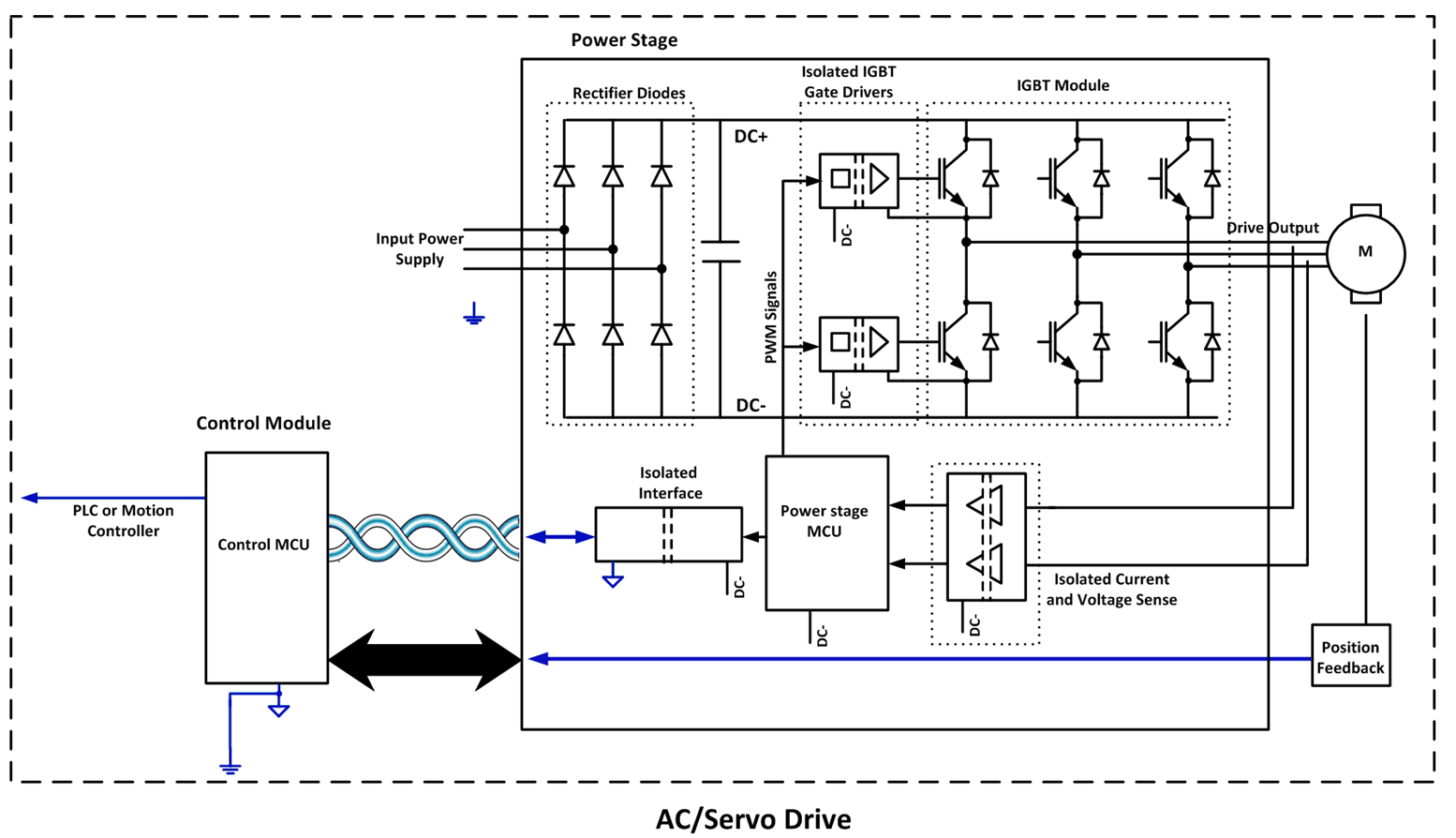SLLA473 January 2020 ISO1450 , ISO1452 , ISO7821LL
1 TI Tech Note
AC Motor Drives
AC Motor drives, also known as Variable Frequency Drives (VFD) are ubiquitous in industrial and commercial applications. Their primary function is to convert a fixed frequency AC input voltage into a voltage with variable frequency and amplitude to drive the motor at variable torque and speed as per the load demands. Some examples include conveyors, cranes and hoists, winding machines, fans and pumps. Depending upon the precision of control required, AC drive can be sensor less or it can have position feedback.
Servo Drives
Servo drives are an integral part in factory automation. Applications requiring fast transient response, precise position control and synchronization between multiple axes such as robots deploy servo drives. Other applications of servos include industries such as packaging, textile and storage.
Drive Architecture
Figure 1 shows a possible architecture that can apply to either an AC drive with position feedback or single-axis servo drive. The input voltage is typically either a single phase or three-phase AC mains voltage which is then rectified to a DC voltage. This DC voltage is fed to an inverter stage which uses a three-phase IGBT (insulated gate bipolar transistor) power stage being pulsed using pulse width modulation (PWM) to convert the DC voltage into an AC waveform that can drive a three-phase AC motor. The power stage microcontroller (MCU), which is referenced to DC-, is in the high voltage (HV) domain. This MCU generates six PWMs which are adjusted based on the closed loop current feedback and from the commands received from the other MCU, designated as control MCU which is located in low voltage (LV) domain. Functional isolation is needed from HV side MCU to IGBT gate driving and to isolated current/voltage feedback. Reinforced isolation is needed between the HV side MCU and LV side MCU because LV side is safety earth and is accessible to human interface.
 Figure 1. AC/Servo Drive
Figure 1. AC/Servo Drive Isolated Interface Block
Let’s focus on the isolated interface block between the two MCUs. A programmable logic controller (PLC) or motion controller may control the drive and control information will need to be transferred from LV side MCU to HV side. This interface may also have current and voltage parameters of the motor being transferred from HV side to the LV side. Since data transfer is in both directions and to ensure accurate speed and position control of the motor, a high speed full duplex communication link between HV and LV domains is desirable.
Various options for interface such as SPI, RS-485, LVDS or Fiber optic link are possible. System designers select the communication interface depending on factors such as distance of communication, data rate, latency and cost. Typically distance between the control board and power board can range from few centimeters up to multiple meters. SPI being single ended CMOS signaling is usually not a preferred interface in the noisy environment of drives because it can easily be corrupted by noise. CMOS signaling with fast edges traveling on long traces or cables can also radiate a lot making the complete system fail radiated emissions test. Fiber optic links meet the data rate and distance requirements, but are usually quite expensive. Furthermore, fiber optic links may be overkill as it can go up to 1-Gbps, but in most practical applications 50 Mbps is sufficient. This leaves us with two options, RS-485 and LVDS. Both are differential wired interfaces; provide good common mode noise rejection while allowing communication at the required distances. Table 1 below shows a comparison between both interfaces:
Table 1. RS485/LVDS Comparison
| Parameter | RS485 | LVDS |
|---|---|---|
| Max Data rate | 50 Mbps | 1 Gbps+ |
| Max communication distance | Up to 1000 mts | 10 s of meters |
| Common mode range supported(per standard) | -7 to 12 V | 0 to 2.4 V |
| Typical signal swing(pk-pk) | 3 V | 350 mV |
| Power consumption | Medium | Low |
| Cost | Low | Medium |
For systems that require data rates up to 50 Mbps, Isolated RS-485 presents a more cost-effective solution with below benefits:
- Higher signal-to-noise ratio (SNR) because of the higher peak-peak swing.
- Supports wider common mode voltage range, so communication to longer distances is feasible.
- Controlled slew rate of drive output does not worsen system radiated emissions.
For systems which require higher data rates than 50 Mbps or lower power consumption, isolated LVDS may be more attractive with TI’s dual isolated LVDS buffer, ISO7821LL, which consumes less than 30 mA maximum at 100 Mbps (5 V supply corner, total current consumption on both sides of the device).
TI Solutions
TI offers a wide variety of isolated RS-485 solutions, including the ISO1452 which is a perfect fit for high speed MCU to MCU RS-485 communication in motor drives. In addition to the integrated 50-Mbps full duplex transceiver, ISO1452 also offers 16-kV IEC ESD (electrostatic discharge) and 4-kV IEC EFT(electrical fast transient) protection on the bus and 85 kV/us CMTI (common-mode transient immunity) to ensure reliable communication in harsh industrial environments. The 1500 VPK continuous working voltage capability ensures that the same device can be used in both single phase and three-phase AC supply motor drive platforms, simplifying the development process.
Conclusion
Accurate, fast and low-latency communication between the control stage and power stage is necessary for a motor drive system to operate reliably. TI offers a wide variety of isolated interface products, including the ISO1452 and ISO7821LL, to help simply the design process for systems engineers facing the challenge of providing reliable and fast communication across the isolation barrier.